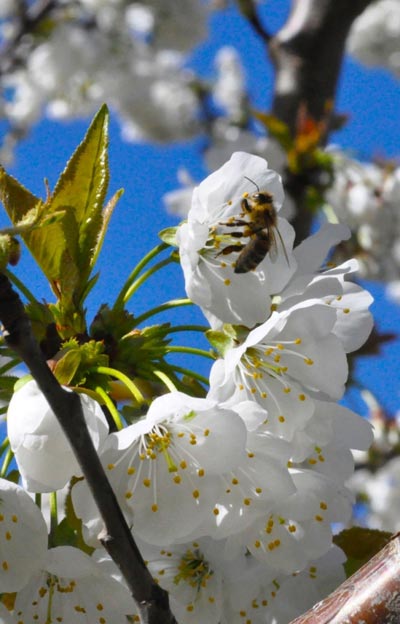Flying Doctor Bees to Prevent Cherry Disease

This is a new technique for Australia and a world first for cherry orchards with potential application in many horticultural industries. It will be demonstrated publicly for the first time at a field day today hosted by Cherry Growers of South Australia and the researchers at Lennane Orchards, Montacute.
“Brown rot is caused by a fungus which significantly impacts the $150 million Australian cherry industry through costs of applying fungicide, yield loss and fruit spoilage,” says project leader and bee researcher Dr Katja Hogendoorn, postdoctoral research associate with the University’s School of Agriculture, Food and Wine.
“All commercial cherry growers spray during flowering to control the later development of cherry brown rot. Instead of spraying fungicide, we’re using bees to deliver a biological control agent right to the flowers where it is needed. This uses an innovative delivery method called entomovectoring.”
The biological control agent contains spores of a parasitic fungus that prevents another fungus that causes the brown rot from colonising the flower. Every morning, the cherry grower sprinkles the spores into a specially designed dispenser that has been fitted in front of the hive. The bees pick up the spores between their body hairs and bring them to the flowers.
“The ‘flying doctors’ technology is used successfully in Europe to control strawberry grey mould, but it’s the first time for Australia and the first time in cherry orchards anywhere,” Dr Hogendoorn says.
Dr Hogendoorn says the use of bees has many environmental and economic benefits compared to spraying fungicide.
“The bees deliver control on target, every day,” she says. “There is no spray drift or run-off into the environment, less use of heavy equipment, water, labour and fuel.”
Dr Hogendoorn says adoption of the technique will have the additional benefit of building up the honey bee industry and the number of managed hives. This will help prepare Australia for the expected incursion of the Varroa mite which is causing great damage and cost to bee and horticultural industries around the world.
With increasing availability of suitable biological control agents, future application of the ‘flying doctors’ technology is expected to become available for disease control in almonds, grapes, strawberry, raspberry, apple, pear and stone fruit.
The ‘flying doctors’ project is funded by the Australian Government through a Department of Agriculture Innovation Grant.
Media Contact:
Dr Katja Hogendoorn
Postdoctoral research associate
School of Agriculture, Food and Wine
The University of Adelaide
Phone: +61 8 8313 6555
Mobile: +61 409 728 869
katja.hogendoorn@adelaide.edu.au
Robyn Mills
Media and Communications Officer
The University of Adelaide
Phone: +61 8 8313 6341
Mobile: +61 410 689 084
robyn.mills@adelaide.edu.au
Media Contact
All latest news from the category: Agricultural and Forestry Science
Newest articles

NASA: Mystery of life’s handedness deepens
The mystery of why life uses molecules with specific orientations has deepened with a NASA-funded discovery that RNA — a key molecule thought to have potentially held the instructions for…

What are the effects of historic lithium mining on water quality?
Study reveals low levels of common contaminants but high levels of other elements in waters associated with an abandoned lithium mine. Lithium ore and mining waste from a historic lithium…

Quantum-inspired design boosts efficiency of heat-to-electricity conversion
Rice engineers take unconventional route to improving thermophotovoltaic systems. Researchers at Rice University have found a new way to improve a key element of thermophotovoltaic (TPV) systems, which convert heat…



